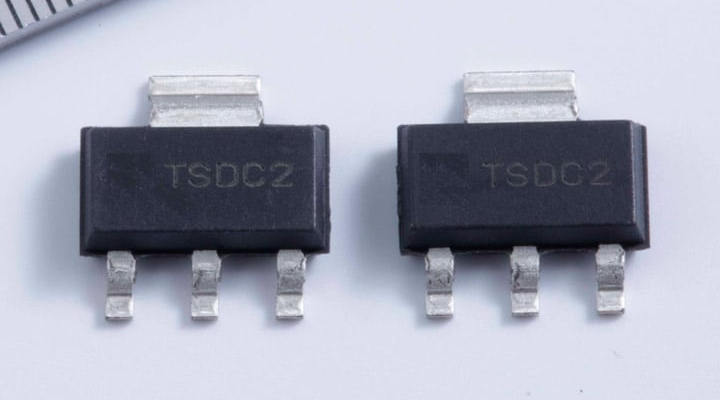Using the Small Outline Transistor 23 package (SOT 223) can be a helpful addition to your semiconductor devices. For good reasons, the package has become a reference point for real-time heat dissipation, ensuring thermal balance and boosting the overall performance of the circuit board.
In this article, we dissect the most integral parts of the package, including some of the technical properties.
What is SOT 223?
It is a type of Small Outline Transistor (SOT) designed for consumer electronics with smaller footprints. The most outstanding feature is the variations, notable among which is the SOT 223-3. This variation is closely related to the standard SOT 23 package, only that it uses a tab on one side of the package.
Understanding the Naming Conventions

The naming process or convention of the SOT 223 also serves as one of the focal points when looking to buy the package.
Depending on the manufacturer and the integral properties, the conventions may differ. For example, it is common to stick to the SOT 223-x, where the “x” signifies the number of pins the package has.
However, you may also come across the following variations of the name:
- SOT 223-3: It is commonly used to denote the SOT 223 package with one tab and 3 pins.
- SOT 223-4: This naming convention is common if the package has four pins and a tab.
SOT 223 vs DPAK
The Small Outline Transistor 223 (SOT 223) is sometimes compared to the Decawatt Package (DPAK). It has been muted too that the SOT 223 is a better replacement to the former.
Let’s see some of the reasons:
1. Direct Replacement
SOT 223 is best described as a “direct replacement to the DPAK” because of the former’s smaller footprint. At an estimate, the SOT 223 tends to operate on a smaller footprint and compete favorably against the DPAK, only if the thermal junction temperature is at 5-degree Celsius.
It works in two ways. In the first option, the SOT 223 can use a smaller or minimum footprint if the DPAK is up to 20mm2 larger than the DPAK footprint.
On the other hand, the SOT 223 becomes a direct replacement of the DPAK, when the copper area connected to the DPAK’s drain pin is larger than 100mm2. When that happens, the SOT 223 does not only become its direct replacement, but also uses up to 3-degree Celsius temperature.
2. The Middle Pin Connection
The middle pin is left out of the SOT 223 architecture and that is one of its competing factors to the Decawatt Package (DPAK). In this case, the absence of the middle pin means that the SOT 223 allows for both second sourcing and one-on-one drop-in replacements for the components.
By decapping the middle pin, the SOT 223 package also reduces the footprint, which, in tur, helps to slightly increase the mould compound temperature.
Advantages of the SOT 223 Package

Asides from a reduced footprint and a balanced thermal performance, the SOT 223 also has some other benefits. Here are some of those:
Flexible Copper Area
The package’s copper area has a role to play in its overall thermal performance. To put it into perspective, there are up to three (3) different copper area modifications that helps the package do that.
Here are some of them:
- 40 mm2 Copper Area: This copper area aligns with the standard minimum copper area required for the minimum pad dimensions of the DPAK package. In that case, the 40˚C copper area aligns with the recommended junction temperature of 84˚C.
- An additional 10mm2 to the existing footprint leads to a higher junction temperature, up to 14-degree Celsius. When this addition is made, the SOT 223 tends to enable the optimization of the package for applications requiring lesser footprints and more optimized power levels.
- When an additional 40mm2 copper area is added to the SOT 223, it attains an additional 5-degree Celsius junction temperature. With that, the package is optimized for direct drop-in optimizations, thus making it a drop-in replica of the Decawatt Package (DPAK).
- The SOT 223 package, by default, has some disadvantages, especially with the design. These downsides can be tackled with the addition of more 40mm2 copper area. The connection has to be made close to the package’s drain pin, as that helps to reduce the DPAK minimum footprint.
BOM Cost Reduction
In addition to cutting down on the package’s footprint and increasing the junction temperature, the SOT 223 also helps to save costs.
Up to 10% overall cost reduction in the Bill of Material (BOM) can be achieved, partly because of the smaller footprint and mainly because of the additional footprint optimization in some SOT 223 variations.
Applications and Use Cases
SOT 223 package is used with low-power applications, especially when the additional 10mm2 is applied and a 5-degree Celsius junction temperature is tenable.
You can also use the package with the following applications:
- Linear Regulators: The SOT 223 is commonly paired with the medium and small-power linear regulators. The de-facto standard pinout process is used in this case.
- Load Switches: You can also use the SOT 223 package with both the high-side and low-side load switches.
- The package is also usable with voltage regulators, transistors and diodes.
Variations of the SOT 223 Package
The variants tend to share the same thing in common – they are cost-effective and flexible too. However, you want to note that these package variants have individual capabilities.
The SOT 223-4 and the SOT 223-5 are commonly used with voltage regulators. However, the SOT 223-8 is optimized for bridged quad transistors.
Examples of other SOT 223 package variations are:
SOT 223-3
It is the most common of the SOT 223 transistor packages. Included in the package are 3 pins and one tab.
The variant also has two use cases – it is used with both the load switches and the medium-power linear regulators. Thus, it combines the applications of the SOT 223-4 and the SOT 223-5 packages.
Conclusion
The SOT 223 is an excellent choice for Small Outline Transistor (SOT) package consumers looking to balance smaller footprint circuit boards with thermal performance. The SOT 223-3 is one of the most reliable variants you can work with, because of the dual use cases and the replacement of the legs on a side with a tab.
